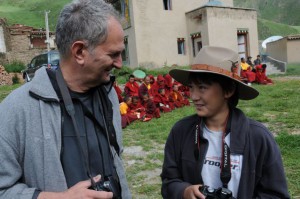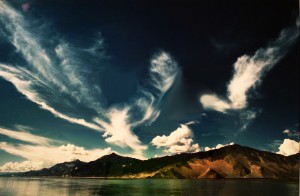Monday
Community ArticlesReborn in Tibet, part 3
Lhasa 1986
by Lee Weingrad
“It’s not a question of discovering who you are. It’s a question of discovering who you are not!”
Chogyam Trungpa, Rinpoche 1984, Boulder
It was a strange thing for me to think, “I know everything about this place.” It wasn’t deja vu. It wasn’t an instant sense of, “I could live here,” the way I felt in Amsterdam in 1995. It wasn’t a feeling of love. It was instant connection and familiarity coming up from the earth, through the soles of my feet, in a way that Kathmandu was not. A week earlier I was riding with Tim Olmstead on his motor scooter through the crowded, exhaust-choked streets of Bodha. There were cows everywhere. Sacred cows. He said to me, “if you get into a traffic accident and hit a cow, leave the country.” Wow. That got my attention. It made me feel like I was in an episode of Star Trek that was left on the cutting room floor. Lhasa was not all that foreign.
I settled into the Kirey Hotel, in the Kirey district near the Barkhor. The Barkhor is the inner circumambulation (khora, Tib.) circle in Lhasa, the road that surrounds the Jokhang, the temple that contains the holiest statue in Tibet, the Jowo Rinpoche. It was a place I would get to know very well.
I checked in. It seemed, amazingly that the owner, Dawa and all the young women who worked there were in on some joke, because no matter what happened in the next month I stayed there, they were laughing. When they saw something funny they would laugh. When they hurt themselves, they would laugh. Especially when I would try to photograph them and they would dive under the table in the office. I would start to get the joke, which involved the delight not just in everyday life, but in the very weirdness of foreigners.
My goal was to find a ride from Lhasa to Surmang. But I realized that I needed to get to know how the place worked, to tune into it, rather than burst upon this place.
Although late in the afternoon, I wasted no time after check-in, walking the ¼ mile over to the Jokhang. The front of the temple was crowded with pilgrims, about 20 of which were doing full prostrations to the building and the Jowo Rinpoche inside. Outside, there were two 15 foot-high white conical incense pots, with juniper lhasang releasing vast billows of white smoke. There was a stele, a stone post with a notice written by the Chinese Tang Emperor in Tibetan, Mongolian, and Chinese. All in front of a vast square, Soviet style, the communist government had created by clearing a whole section of apartments.
And of course there were groups of people: short apron-clad Lhasa women, and the men, with their Newari-square faces, monks, tall Khampas with their black chubas and long ribbon adorned hair braids wrapped around the tops of their heads. And dogs, lots of dogs. Aside from the din of mantras chanted you could hear people laughing, an echo of the women at the Kirey. It was the bar scene from Star Wars.
I couldn’t see any foreigners. This was my first day in Lhasa.
Over the next month, I would go to the Barkhor nearly every day. I started to notice some interesting details. Like the street in front of the Kirey was “Renmin Lu”, meaning, in Chinese, “the people’s street.” There was hardly any traffic. It was quiet. I remember the dogs, mangy, but somewhat aware of their place. They mostly lived on picking through the omnipresent garbage piles. One day in the meat market I noticed that there were dogs who lived there too, under the tables of the meat vendors. It taught me something about karma.
On my second day I went to the Jokhang. Until 6 or 7 years before it was closed by the Red Guards and converted into a pig stye. It houses the Jowo Rinpoche, a life-sized statue of the 9 year-old Shakyamuni Buddha. It was given by the daughter of the Tang emperor, Princess Wen Cheng Gongjiu, in the 700’s to her husband, the Tibetan King, Songtsen Gampo. It is said that the Tang Emperor had it brought from India and that it was made during the lifetime of Shakyamuni Buddha and blessed by him. If this is true, it is the only such extant statue of Lord Buddha.
Now, 6 years after the demise of the Cultural Revolution and the Gang of Four, it seemed like, “and now back to your regularly scheduled program.” Making my way, I only had a very rudimentary knowledge of Tibetan. I could utter totally dysfunctional phrases, like thamal gyi shepa and Dorje Palmo. Nearly useless. My Chinese was relatively much better. I arrived at the Jokhang entrance to find out that it was closed to visitors. Through the crack in the door, I told the monk in Chinese that I was an American Buddhist on pilgrimage to my lama’s monastery in Kham. Smiling and uttering a mantra, the door opened. About 10 Tibetan pilgrims followed.
The inner courtyard was awash in butter lamps. Hundreds of them. The outer chamber of the Jokhang was dark and had the smell of yak butter. There was Guru Rinpoche. There was Maitreya Buddha.
I went to the Barkhor nearly every day. I met now-famous Bönpo Lama Tenzin Wangyal there. I felt that I was beginning to get into the rhythm of the Lhasa. It had a very open feeling, since there were very few tourists, and no one knew what to do with us foreigners. Travel permits to even be in Lhasa were either mandatory or irrelevant, depending who you talked to. Many of us tested the limits of the new openness. A friend of mine, and devoted student of Trungpa Rinpoche, Paul Kloppenburg, made it all the way to Pema Kö near India in S. Tibet searching for 1000 pages of Trungpa Rinpoche’s abandoned writings before some local official pulled the plug and he got sent back to Lhasa. I felt like I was in some reincarnation of Paris in the 20’s. With bad food.
Next installment coming soon…
~~
 Lee Weingrad, also known as Wangli, was born in New York City and is a product of a middle class Jewish family and suburban New York City public schools. In 1972 he met Chogyam Trungpa Rinpoche and has been a student of his ever since. In 1986 he took his first trip to abroad: to Tibet, journeying overland from the Nepal border. He lives with his wife Wang Wenjing and children in Beijing. Meeting Trungpa Rinpoche’s eldest son, Sakyong Mipham Rinpoche, in Kathmandu, the two decided to form Friends of Surmang, to bring some help to Surmang Tibetans in the form of clinics, hospitals and other kinds of community development. Lee has transitioned away from English teaching to concentrate on the Surmang Foundation’s work fulltime. Learn more about the Surmang Foundation here.
Lee Weingrad, also known as Wangli, was born in New York City and is a product of a middle class Jewish family and suburban New York City public schools. In 1972 he met Chogyam Trungpa Rinpoche and has been a student of his ever since. In 1986 he took his first trip to abroad: to Tibet, journeying overland from the Nepal border. He lives with his wife Wang Wenjing and children in Beijing. Meeting Trungpa Rinpoche’s eldest son, Sakyong Mipham Rinpoche, in Kathmandu, the two decided to form Friends of Surmang, to bring some help to Surmang Tibetans in the form of clinics, hospitals and other kinds of community development. Lee has transitioned away from English teaching to concentrate on the Surmang Foundation’s work fulltime. Learn more about the Surmang Foundation here.

















